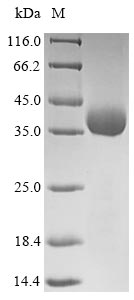The Recombinant Rotavirus X Outer capsid protein VP4 is a crucial tool in virology research. Derived from the isolate RVX/Human/Bangladesh/NADRV-B219/2002/GXP[X], the VP4 Outer capsid protein plays an integral role in understanding viral mechanisms. The yeast-expressed product focuses on a partial region, from the 1st to 249th amino acid, offering a comprehensive view of the protein's behavior and interactions.
The recombinant protein is designed with an N-terminal 6xHis-tag, facilitating easy purification and detection during your investigations. This product's purity exceeds 85% as determined by SDS-PAGE, showcasing its high-quality construction. Available in either liquid or lyophilized powder forms, it can be seamlessly incorporated into your existing laboratory workflow. Rely on our Recombinant Rotavirus X Outer capsid protein VP4 to deliver consistent and reliable data in your research.






